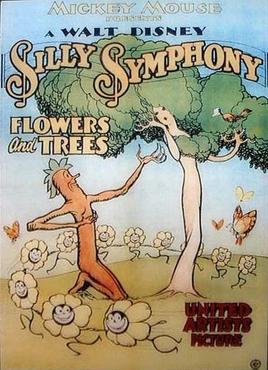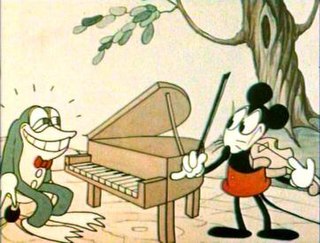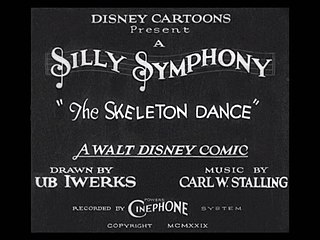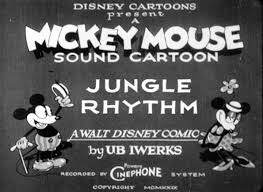Related Research Articles

Ubbe Ert Iwerks, known as Ub Iwerks, was an American animator, cartoonist, character designer, inventor, and special effects technician, known for his work with Walt Disney Animation Studios in general, and for having worked on the development of the design of the character of Mickey Mouse, among others. Born in Kansas City, Missouri, Iwerks grew up with a contentious relationship with his father, who abandoned him as a child. Iwerks met fellow artist Walt Disney while working at a Kansas City art studio in 1919.

Plane Crazy is a 1928 American animated short film directed by Walt Disney and Ub Iwerks. The cartoon, released by the Walt Disney Studios, was the first appearance of Mickey Mouse and his girlfriend Minnie Mouse, and was originally a silent film. It was given a test screening to a theater audience on May 15, 1928, and an executive from Metro-Goldwyn-Mayer saw the film, but failed to pick up a distributor. Later that year, Disney released Mickey's first sound cartoon, Steamboat Willie, which was an enormous success; Plane Crazy was officially released as a sound cartoon on March 17, 1929. It was the fourth Mickey film to be given a wide release after Steamboat Willie, The Gallopin' Gaucho and The Barn Dance (1929).
Silly Symphony is an American animated series of 75 musical short films produced by Walt Disney Productions from 1929 to 1939. As the series name implies, the Silly Symphonies were originally intended as whimsical accompaniments to pieces of music. As such, the films usually did not feature continuing characters, unlike the Mickey Mouse shorts produced by Disney at the same time. The series is notable for its innovation with Technicolor and the multiplane motion picture camera, as well as its introduction of the character Donald Duck making his first appearance in the Silly Symphony cartoon The Wise Little Hen in 1934. Seven shorts won the Academy Award for Best Animated Short Film.

Flowers and Trees is a Silly Symphonies cartoon produced by Walt Disney, directed by Burt Gillett, and released to theatres by United Artists on July 30, 1932. It was the first commercially released film to be produced in the full-color three-strip Technicolor process after several years of two-color Technicolor films. The film was a commercial and critical success, winning the first Academy Award for Best Cartoon Short Subject.

Flip the Frog is an animated cartoon character created by American animator Ub Iwerks. He starred in a series of cartoons produced by Celebrity Pictures and distributed by Metro-Goldwyn-Mayer from 1930 to 1933. The series had many recurring characters besides Flip, including Flip's dog, the mule Orace, and a dizzy neighborhood spinster.
Burton F. Gillett was a director of animated films. He is noted for his Silly Symphonies work for Disney, particularly the 1932 short film Flowers and Trees and the 1933 short film Three Little Pigs, both of which were awarded the Academy Award for Best Animated Short Film and both of which were selected for inclusion in the National Film Registry.

The Skeleton Dance is a 1929 Silly Symphony animated short subject produced and directed by Walt Disney and animated by Ub Iwerks. In the film, four human skeletons dance and make music around a spooky graveyard—a modern film example of medieval European "danse macabre" imagery. It is the first entry in the Silly Symphony series. In 1993, to coincide with the opening of Mickey's Toontown in Disneyland, a shortened cover of the cartoon's music was arranged to be featured in the land's background ambiance. The short's copyright was renewed in 1957, and as a published work from 1929 it will enter the US public domain on January 1, 2025.
Wild Waves is a Mickey Mouse short animated film first released on December 18, 1929, as part of the Mickey Mouse film series. It was the fifteenth Mickey Mouse short to be produced, the twelfth of that year, as well as the last to be released by Celebrity Productions before Columbia Pictures took over distribution.
Fiddlesticks is a 1930 Celebrity Pictures theatrical cartoon short directed and animated by Ub Iwerks, in his first cartoon since he departed from Walt Disney's studio. The short features Iwerks' character Flip the Frog. It is the first complete sound cartoon to be photographed in color.
Midnight in a Toy Shop is an American 1930 Silly Symphonies animated short film directed by Wilfred Jackson and produced by Walt Disney Productions.
The Spider and the Fly is a 1931 Silly Symphonies cartoon.
Springtime is a Silly Symphonies animated Disney short film. It was released in 1929. It was the third Silly Symphonies film to be produced, just five days before the 1929 Stock Market Crash. The short's copyright was renewed in 1957, so it will enter the US public domain on January 1, 2025.
Autumn is a Silly Symphonies animated Disney short film. It was released on February 13, 1930, by Columbia Pictures. It was the final Disney cartoon that Ub Iwerks animated.
Cannibal Capers is a Silly Symphonies animated Disney short film. It was released in 1930.
Arctic Antics is a Silly Symphonies animated Disney short film. It was released on June 26, 1930.
Winter is a Silly Symphonies animated Disney short film. It was released on October 30, 1930, by Columbia Pictures.
The Cat's Out is a Silly Symphonies animated Disney short film. It was released in 1931. The Cat's Out was a working title that survives on an existing vault print; the short was originally copyrighted and released as The Cat's Nightmare.

The Haunted House, also known as Haunted House, is a 1929 Mickey Mouse short animated film released by Celebrity Productions, as part of the Mickey Mouse film series. The cartoon was produced by Walt Disney Productions and distributed by Celebrity Productions. It was the fourteenth Mickey Mouse short to be produced, the eleventh of that year.

Jungle Rhythm is a Mickey Mouse short animated film first released on November 15, 1929, as part of the Mickey Mouse film series. It was the thirteenth Mickey Mouse short to be produced, the tenth of that year.
Hell's Bells is a 1929 animated short film was directed by Ub Iwerks and was distributed into cinemas by the film company Columbia Pictures, who would also distribute other Walt Disney films, such as Winter. The film follows Satan and the other devils' happenings in Hell. One of these devils revolts against Satan, and end up kicking him off the cliff of Hell at the end of the film. The short is part of short film series Silly Symphonies.
References
- 1 2 3 Merritt, Russell; Kaufman, J. B. (2016). Walt Disney's Silly Symphonies: A Companion to the Classic Cartoon Series (2nd ed.). Glendale, CA: Disney Editions. pp. 66–67. ISBN 978-1-4847-5132-9.
- ↑ Bradley, Edwin M. The First Hollywood Sound Shorts, 1926–1931. p. 153.
- ↑ "Corking Comedies Highlight Short Releases". Motion Picture News : 80. February 1, 1930. Retrieved February 23, 2020.
- ↑ "Talking Shorts". Variety : 24. February 26, 1930. Retrieved February 23, 2020.